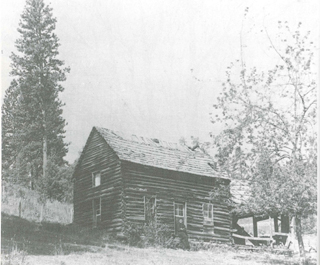| The
Cottonwood story as it may have happened
Imagine in the early fall of 1861 a group of weary travelers, maybe 4-6 wagons, traveling down the slope of what was known as Craig Mountain. As they came down they looked 20 odd miles ahead across the wide prairie to the trees leading up the next mountain into wilderness. This must be their goal, Mt. Idaho and the way to the mining camps of which they had heard. 
While they slowly moved down the hill a stagecoach caught up with them and they all stopped to visit a little. The stagecoach driver told them of a spot near the bottom where they could stop, rest and water their horses. “You’ll come to a little gully about 2 miles down, followed it for another ½ mile to the main creek.” And so they did. This is where the watering hole was. This is where several in the group decided to spend the winter instead of up in those mountains. Dragging a few logs from the trees they started to make wood and secure a place to spend the winter. A true “Indian Summer” did prevail and the leader of the group with his family became fully satisfied that this was a good place to stay with lots of water, food and fuel. The next spring this man called “Allen” started construction on the big cabin called “Cottonwood House” so named of the big trees on this fork of the creek. Shortly after, in the spring of 1862, Cottonwood was named a way station and corrals were built behind the hotel and practically every week more corrals were added. Later there was a sheep corral or holding pen on the north side of main street. Slowly but surely, other small cabins and businesses began to “pop up” on Main Street. Some early ones set up going north on what is now known as King Street. The cattle corral expanded to the west and soon was used for the horse round-up. Later many horses were taken from the Camas Prairie herds, which had grown to as many as three thousand, and run to southern Idaho on the Boise Trail where they were used by the Army. Stories talk of several hundred horses driven south at a time. The center for the military was Mt. Idaho and a government was built there. If the early settlers had trouble, someone was sent to Mt. Idaho to ask for the Calvary to come. For the first 14 or 15 years white man and the Indians got along with only a few squabbles. Early settlers tell many tales of trade and barter with the Indians. Also during this time, about the start of the Civil War, public unrest in Europe and extreme poverty in Ireland led to people coming across the United States on the transcontinental railroad to places like here on the prairie where settlers were welcome. While the people continued to come looking for land, others were working the opportunity to make their money buying and selling land. (This was a risky business as future stories will show.) One of the biggest early attractions was “where people go the railroad is sure to follow.” The railroad giants of industry had handled many problem areas across the United States. This area was a challenge, but definitely on their schedule. First the population had to grow, then the livestock industry, the farm products had to increase, but the major interest in the first few years was the mining industry. Man oh man did news fly. Orofino Creek, Orogrande, Buffalo Hump, Florence, Dixie and the Salmon River. Here they came from all over the world looking for gold and silver. Wagon after wagon, with tools, machinery, men and supplies. Some came alone, but many brought their anxious bride and a few brought their whole families. “Sure it’s tough now, but wait until we strike it rich.” Underneath it all was the stability of the farmer and the rancher ready to till the soil and feed all the people. Some people bought out others and some homesteaded on their own. Some families moved two or three times before they had what they wanted. Yes “salt of the earth” that’s what they were and what their descendants are 3, 4 and 5 generations later. About this time in Lewiston, many things that would affect us all were in progress as the capital of this new territory was located there and legislators from all over the territory were meeting to adopt rules that would govern all for, at least, the next few years. Also there was a group that wanted to move the capital to Boise. Also at the same time 4 men were being tried for the murder of a local businessman by the name of Magruder. One of the men turned in to testify against the others. Then, after a speedy trial, the men called Lowry, Renten and Romain were hanged on March 3, 1863. The spring of 1863 was wet and cold. Winter, as it often does, wouldn’t let go and give way to spring. The creek wouldn’t stay put and the trail through town was muddy with the wagons often getting bogged down. All this was a part of life. It seemed the whole world was against these pioneers. Persevere they did and the sun did come out and in a few weeks the wagons started to come once again |
|